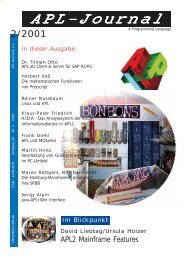APL-Journal - APL Germany e. V.
APL-Journal - APL Germany e. V.
APL-Journal - APL Germany e. V.
Create successful ePaper yourself
Turn your PDF publications into a flip-book with our unique Google optimized e-Paper software.
<strong>APL</strong>-<strong>Journal</strong><br />
Dyalog Version 11.0<br />
Morten Kromberg<br />
With the addition of classes and the ŒNEW system function<br />
for creating instances of classes, version 11.0 is the first version<br />
of Dyalog <strong>APL</strong> with core language support for writing<br />
object oriented applications. However, objects are not entirely<br />
new to Dyalog <strong>APL</strong> – the first objects appeared in the language<br />
around 1990.<br />
The first recognisable „objects“ were introduced into<br />
Dyalog <strong>APL</strong> when the Windows GUI interface was added in<br />
version 6.3 – in the early 1990’s. Apart from the word property<br />
to describe a „variable which was a child of a GUI object“,<br />
object terminology never really caught on in the <strong>APL</strong><br />
community – but whether we knew it or not, GUI elements<br />
like forms, labels or buttons were in fact classes that the <strong>APL</strong><br />
developer could create instances of, and these instances had<br />
properties and methods.<br />
The new objects were created and manipulated using a set<br />
of new system functions,ŒWC for the creation of objects,<br />
ŒWG and ŒWS for getting and setting the value of properties,<br />
and ŒNQ for triggering events and calling methods. The<br />
original syntax required the names of objects and their members<br />
to be given as strings. For example, the statement<br />
'MyForm' ŒWS 'Caption' 'Hello World'<br />
… would set the caption of MyForm. Over the next<br />
few years, Dyalog <strong>APL</strong> learned to recognize COM and<br />
Microsoft.Net classes and objects. Within <strong>APL</strong>, we were able<br />
to create namespaces, which were objects in that they contained<br />
collections of variables and functions. With namespaces came<br />
the familiar (to some) dot notation which <strong>APL</strong> shares with<br />
most other object-oriented languages, allowing the above<br />
expression to be shortened to:<br />
MyForm.Caption½'Hello World'<br />
… which is an obvious improvement in terms of readability.<br />
Finally, it was realized that references to objects could<br />
be stored in arrays, and the dot notation could be extended<br />
to allow nested name references, allowing expressions like:<br />
Btns½MyForm.(Button1 Button2 Button3)<br />
Btns.(Caption Posn)½<br />
Ç('Save' 'Cancel' 'Help'),[1.5] 100,¨ ¯40+50×ì 3<br />
Namespaces were different from other objects in that they<br />
were not based on a class definition: Each namespace was<br />
created empty and could be filled with anything the <strong>APL</strong><br />
developer desired. One could perhaps argue that this is „how<br />
<strong>APL</strong> objects should be“, but there are situations where a<br />
blueprint makes ideas clearer and solutions simpler. In particular,<br />
we often want to share the same code between several<br />
namespaces without actually having several copies of the<br />
source code.<br />
In addition to using objects within <strong>APL</strong>, the need for describing<br />
<strong>APL</strong> components in terms which are easily understood<br />
by users of other languages has become very important<br />
as standards like COM and .Net have made it practical<br />
to craft solutions from components written in more than<br />
one language. Although it has been possible to do this in<br />
Dyalog <strong>APL</strong> for several releases, it was clear that this could<br />
become more straight-forward if it were possible to define<br />
classes in <strong>APL</strong>.<br />
The main feature of version 11.0 of Dyalog <strong>APL</strong> is the<br />
introduction of classes as part of the <strong>APL</strong> language. Classes<br />
can be used to create instances. In a nutshell, a class definition<br />
defines the functions and variables which will be available<br />
from within each instance of the class. For example, the following<br />
class definition defines a class for which every instance<br />
will contain the variables Name and Price (and sets<br />
default values for them).<br />
:Class Product<br />
:Field Public Name½''<br />
:Field Public Price½0<br />
:EndClass<br />
This allows:<br />
<strong>APL</strong> - <strong>Journal</strong> 2006, 25. Jg., Heft 1/2 11



